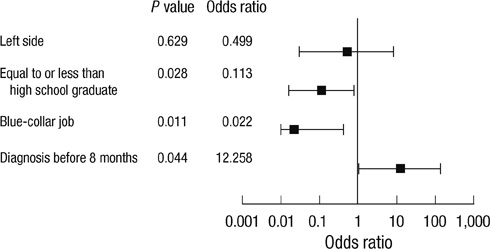J Korean Med Sci.
2012 Aug;27(8):929-933. 10.3346/jkms.2012.27.8.929.
Relationship between Complex Regional Pain Syndrome and Working Life: A Korean Study
- Affiliations
-
- 1Department of Anesthesiology and Pain Medicine, Konkuk University Medical Center, Seoul, Korea. painfree@kuh.ac.kr
- 2Department of Anesthesiology and Pain Medicine, Seoul National University Hospital, Seoul, Korea.
- KMID: 1714206
- DOI: http://doi.org/10.3346/jkms.2012.27.8.929
Abstract
- Complex regional pain syndrome affects the quality of life of the patient. The aim of this study was to investigate the epidemiological features of this syndrome and evaluate its effect on the patient's working life. We demonstrated that the disease has a male preponderance and is 3 times more likely to affect the lower extremities. In this study, 11 participants (20%) retained their employment, whereas 44 (80%) became unemployed. Mean age and pain score were lower in the employment group than in the unemployment group (29.1 +/- 16.8 yr vs 40.1 +/- 12.6 yr, P = 0.021, and 4.5 +/- 2.9 vs 7.0 +/- 2.0, P = 0.002, respectively). Subjects diagnosed within 8 months (P = 0.044), those who had achieved higher levels of education (P = 0.028), and those working in white-collar jobs (P = 0.011) had higher employment-retention rates. Therefore, patients must manage their jobs (lower physical demand and decrease the number of working hours) if they are to improve their occupational life. To achieve satisfactory outcomes and a high employment-retention rate, clinicians must be aware of the importance of an early diagnosis (within 8 months), appropriate treatment, and a reduction in the patient's pain score.
Keyword
MeSH Terms
Figure
Cited by 2 articles
-
The Legal Doctrine on the Liability of Physicians in Medical Malpractice Lawsuits Involving Complex Regional Pain Syndrome
SuHwan Shin, Seung Gyeong Jang, KyeongTae Min, Won Lee, So Yoon Kim
J Korean Med Sci. 2018;33(9):. doi: 10.3346/jkms.2018.33.e46.Multicenter survey of symptoms, work life, economic status, and quality of life of complex regional pain syndrome patients
Jaemoon Lee, Yun Hee Lim, Sung Jun Hong, Jae Hun Jeong, Hey Ran Choi, Sun Kyung Park, Jung Eun Kim, Eun Hi Park, Jae Hun Kim
Korean J Pain. 2021;34(3):288-303. doi: 10.3344/kjp.2021.34.3.288.
Reference
-
1. de Mos M, Sturkenboom MC, Huygen FJ. Current understandings on complex regional pain syndrome. Pain Pract. 2009. 9:86–99.2. Jänig W, Baron R. Complex regional pain syndrome: mystery explained? Lancet Neurol. 2003. 2:687–697.3. Sandroni P. Complex regional pain syndrome type I: incidence and prevalence in Olmsted county, a population-based study. Pain. 2003. 103:199–207.4. de Mos M, Debruijn A, Huygen F, Dieleman J, Stricker B, Sturkenboom M. The incidence of complex regional pain syndrome: a population-based study. Pain. 2007. 129:12–20.5. Galer BS, Henderson J, Perander J, Jensen MP. Course of symptoms and quality of life measurement in complex regional pain syndrome: a pilot survey. J Pain Symptom Manage. 2000. 20:286–292.6. Harden RN, Bruehl S, Stanton-Hicks M, Wilson PR. Proposed new diagnostic criteria for complex regional pain syndrome. Pain Med. 2007. 8:326–331.7. Correll GE, Maleki J, Gracely EJ, Muir JJ, Harbut RE. Subanesthetic ketamine infusion therapy: a retrospective analysis of a novel therapeutic approach to complex regional pain syndrome. Pain Med. 2004. 5:263–275.8. Allen G, Galer BS, Schwartz L. Epidemiology of complex regional pain syndrome: a retrospective chart review of 134 patients. Pain. 1999. 80:539–544.9. Schwartzman RJ, Kerrigan J. The movement disorder of reflex sympathetic dystrophy. Neurology. 1990. 40:57–61.10. Choi YS, Lee MG, Lee HM, Lee CJ, Jo JY, Jeon SY, Lee SC, Kim YC. Epidemiology of complex regional pain syndrome: a retrospective chart review of 150 Korean patients. J Korean Med Sci. 2008. 23:772–775.11. Ciccone DS, Bandilla EB, Wu W. Psychological dysfunction in patients with reflex sympathetic dystrophy. Pain. 1997. 71:323–333.12. Galer BS, Henderson J, Perander J, Jensen MP. Course of symptoms and quality of life measurement in complex regional pain syndrome: a pilot survey. J Pain Symptom Manage. 2000. 20:286–292.13. de Mos M, Huygen FJ, van der Hoeven-Borgman M, Dieleman JP. Outcome of the complex regional pain syndrome. Clin J Pain. 2009. 25:590–597.14. Duman I, Dincer U, Taskaynatan MA, Cakar E, Tugcu I, Dincer K. Reflex sympathetic dystrophy: a retrospective epidemiological study of 168 patients. Clin Rheumatol. 2007. 26:1433–1437.15. Kiralp MZ, Dincer U, Cakar E, Dursun H. Complex regional pain syndrome: epidemiologic features, treatment approaches, workday loss and return to work/disability ratios. Turk J Rheumatol. 2009. 24:1–5.16. Li Z, Smith B, Smith T, Koman L. Diagnosis and management of complex regional pain syndrome complicating upper extremity recovery. J Hand Ther. 2005. 18:270–276.17. Ok SJ, Yang JY, Son JH, Jeong WJ, Lee YS, Kim WY, Park YC. Management of complex regional pain syndrome type 1 with total spinal block. Korean J Pain. 2010. 23:70–73.18. Raja SN, Grabow TS. Complex regional pain syndrome I (reflex sympathetic dystrophy). Anesthesiology. 2002. 96:1254–1260.19. Woolf CJ, Salter MW. Neuronal plasticity: increasing the gain in pain. Science. 2000. 288:1765–1768.20. MacKenzie EJ, Morris JA Jr, Jurkovich GJ, Yasui Y, Cushing BM, Burgess AR, DeLateur BJ, McAndrew MP, Swiontkowski MF. Return to work following injury: the role of economic, social, and job-related factors. Am J Public Health. 1998. 88:1630–1637.21. Kemler MA, Furnee CA. The impact of chronic pain on life in the household. J Pain Symptom Manage. 2002. 23:433–441.
- Full Text Links
- Actions
-
Cited
- CITED
-
- Close
- Share
- Similar articles
-
- Contralateral Mirror Image Spreading in Post-Stroke Complex Regional Pain Syndrome
- Re: Multicenter survey of symptoms, work life, economic status, and quality of life of complex regional pain syndrome patients
- Complex Regional Pain Syndrome
- The Effect of Epidural Ketamine in Complex Regional Pain Syndrome Occuring after Lumbar Epidural Block
- Lived Experience of Middle-Aged Patients with Complex Regional Pain Syndrome


